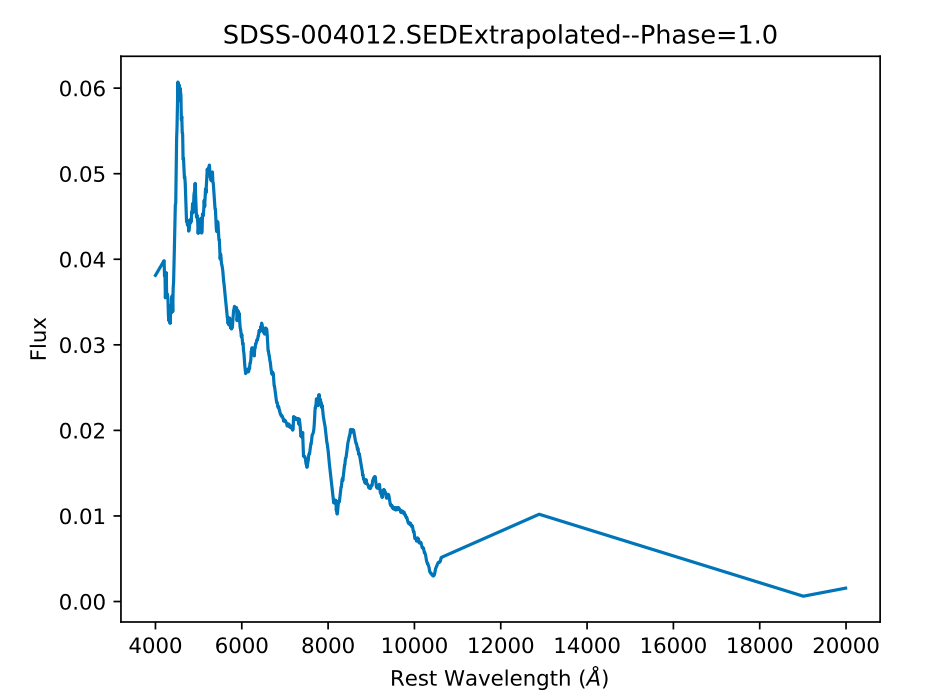Core-Collapse Examples¶
Getting Started¶
Read in a lightcurve and the filename of an SED:
from __future__ import print_function
import snsedextend
sedFile=snsedextend.example_sed
myLC=snsedextend.load_example_lc()
print(myLC)
Out:
name band time mag magerr
------ ---- ----------- ------ ------
2006aj U 53788.16733 18.039 0.078
2006aj U 53790.12301 17.995 0.047
2006aj U 53790.13652 17.982 0.057
2006aj U 53796.11875 18.599 0.112
2006aj U 53797.11978 18.679 0.054
2006aj U 53798.16206 18.738 0.058
2006aj B 53788.11683 18.438 0.05
... ... ... ... ...
2006aj H 53793.12 16.752 0.047
2006aj H 53798.145 16.635 0.037
2006aj K 53788.16 17.183 0.12
2006aj K 53790.133 16.714 0.094
2006aj K 53792.123 16.406 0.145
2006aj K 53793.12 16.393 0.08
2006aj K 53798.145 16.769 0.08
Length = 105 rows
Generate a Color Table¶
Produce a color table from the example data with some assumptions. You can set any parameter that you would like that is used for SNCosmo fitting.
colorTable=snsedextend.curveToColor(myLC,colors=['U-B', 'r-J', 'r-H', 'r-K'],snName='testSN',
snType='Ic', zpsys='vega', bounds={'hostebv': (-1, 1),
't0': (53787.94, 53797.94)},constants={'mwr_v': 3.1,
'mwebv': '0.1267', 'z': '0.033529863', 'hostr_v': 3.1},
dust='CCM89Dust', effect_frames=['rest', 'obs'], effect_names=['host', 'mw'])
Out:
Getting best fit for: U-B,r-J,r-H,r-K
No model provided, running series of models.
Best fit model is "snana-2004fe", with a Chi-squared of 310.573042
Now print the result:
print(colorTable)
Out:
time U-B UB_err ... r-K rK_err SN
float64 float64 float64 ... float64 float64 str6
------------------- ------------------- ------------------- ... ------------------ ------------------- ------
-4.350285244130646 -- -- ... 0.8720948404717248 0.14190154120165033 testSN
-4.350285244130646 -- -- ... -- -- testSN
-4.350285244130646 -- -- ... -- -- testSN
-4.342955244137556 -0.4295303770959613 0.11018996012483721 ... -- -- testSN
-2.3872752441311604 -0.1810379007836005 0.0791907192658557 ... -- -- testSN
-2.3772852441325085 -- -- ... -- -- testSN
-2.3772852441325085 -- -- ... 1.0478962751844385 0.11573043046828127 testSN
... ... ... ... ... ... ...
0.609714755868481 -- -- ... -- -- testSN
3.608464755867317 0.3375874442802953 0.14704748243950216 ... -- -- testSN
4.609494755866763 0.27337763462687903 0.08918839424997288 ... -- -- testSN
5.63471475586266 -- -- ... -- -- testSN
5.63471475586266 -- -- ... -- -- testSN
5.63471475586266 -- -- ... 0.7367464624686129 0.10422322617626094 testSN
5.651774755868246 0.16543738997823354 0.09323158169391926 ... -- -- testSN
Color Curve Fitting¶
Now we can fit this color table and get a best model by minimizing BIC. This function returns a python dictionary with colors as keys and an astropy Table object with time and color vectors as values:
curveDict=snsedextend.fitColorCurve(colorTable)
Out:
Running BIC for color:
U-B
r-J
r-H
r-K
SED Extrapolation¶
Now you can provide an SED to be extrapolated, and let it do the work (This is a type Ic). This will return an sncosmo.Source object and simultanously save the new SED to a file defined by newFileLoc (default current directory).:
newSED=snsedextend.extendCC(colorTable,curveDict,sedlist=[sedFile],zpsys='vega',showplots=False,verbose=True)
Plotting from Timeseries¶
You can directly plot an SED file.:
snsedextend.plotSED('SEDS/typeIc/SDSS-004012.SED',day=1,showPlot=True,MINWAVE=4000,MAXWAVE=20000,saveFig=False)
Out:
